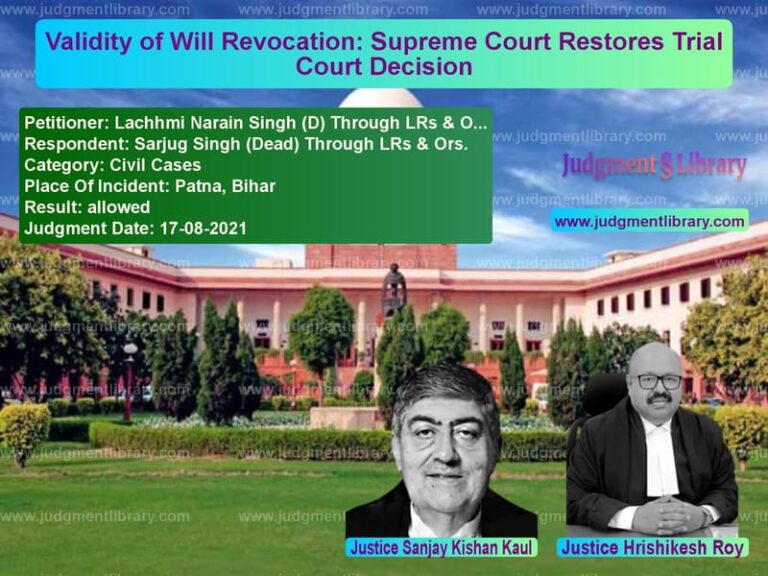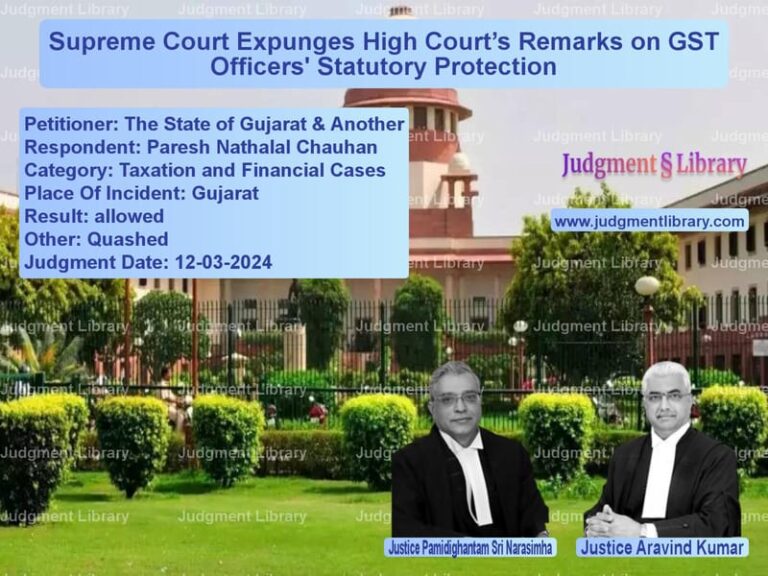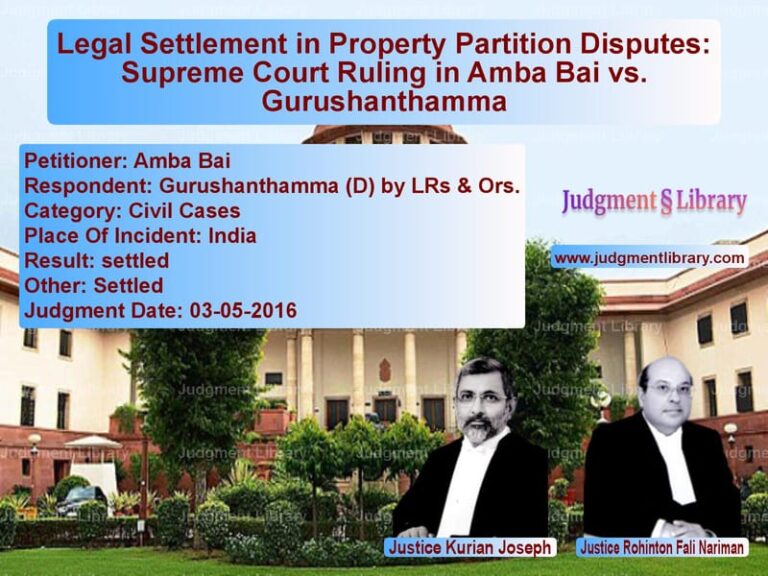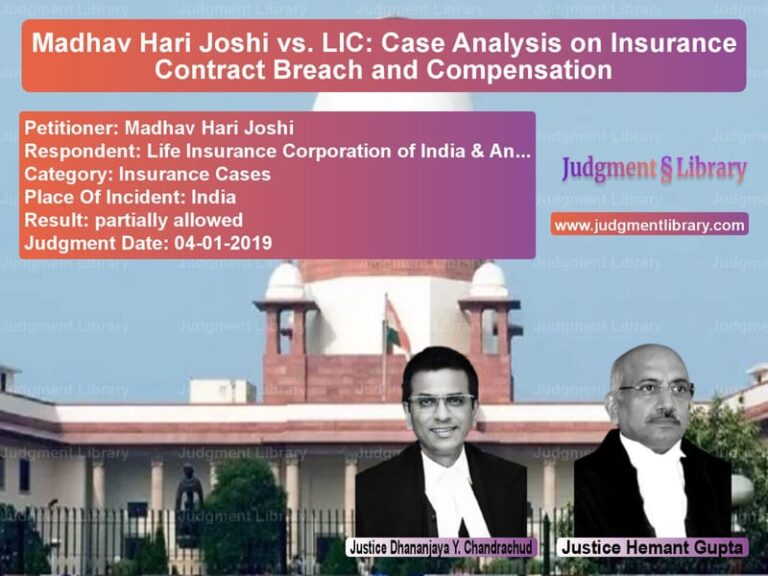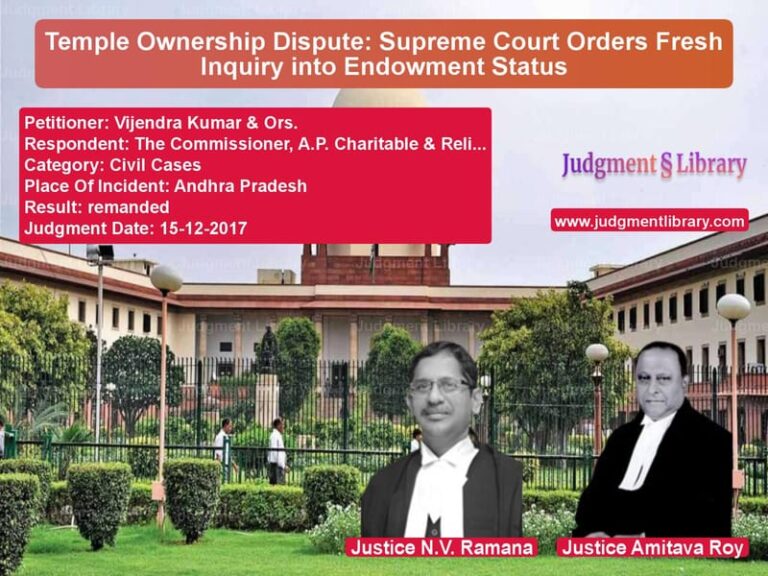Murder and Conspiracy: Supreme Court Restores Conviction in High-Profile Case
The Supreme Court of India recently delivered an important judgment in the criminal appeal filed by the State against the acquittal of the accused by the High Court in the case of State through the Inspector of Police vs. Laly @ Manikandan & Another. The case involved the brutal murder of Saravanan, where the appellants, Laly @ Manikandan (Appellant No. 1) and his associates, were convicted for the offences under Sections 302 and 302 r/w 34 of the Indian Penal Code (IPC). The trial court had sentenced the appellants to life imprisonment, but the High Court of Madras acquitted them, prompting the State to challenge the acquittal before the Supreme Court.
This judgment is crucial as it sheds light on how the courts assess eyewitness testimony and the reliability of evidence when determining the guilt of the accused in criminal cases. The case also provides a deeper understanding of the legal interpretation of sections related to murder and conspiracy under the IPC, along with the judicial scrutiny involved in overturning an acquittal.
Background of the Case
The tragic murder occurred on July 31, 2013, when Saravanan, the deceased, was traveling in a car along with PW1 and another person. The accused, suspecting Saravanan’s involvement in the murder of one of their associates, Selvakumar, attacked the car. The first accused (Appellant No. 1) caused injuries to the right shoulder of Saravanan. The deceased attempted to escape but was chased by the accused and eventually cornered in a shed where they attacked him further, leading to his death. The police investigation revealed that the accused had committed the murder due to personal animosity and a suspected revenge motive.
After the investigation, a charge sheet was filed against the accused for the murder, and they were convicted by the trial court. However, the High Court later acquitted them, citing several inconsistencies and doubts in the prosecution’s case. The State, dissatisfied with the acquittal, filed an appeal before the Supreme Court, challenging the judgment of the High Court.
Arguments Presented by the State
The appellant, represented by the State, argued as follows:
- The prosecution’s case was substantiated by the eyewitness testimony of PW1, who was present during both stages of the attack—when the accused initially attacked the car and when they pursued the deceased to the shed and killed him.
- The High Court had erred in acquitting the accused, as the eyewitness testimony of PW1 was credible and trustworthy, despite certain contradictions in the statements of other witnesses.
- The fact that the accused attacked Saravanan in broad daylight and followed him until his death proved the motive and the intent to murder, making the conviction under Section 302 IPC justifiable.
- The argument that the FIR and complaint were not properly handled, and the delay in registering the FIR, was immaterial in light of the consistent and reliable testimony provided by PW1.
Arguments Presented by the Respondents
The respondents, represented by the accused’s counsel, presented the following counterarguments:
- The key witness, Mahendran, who had lodged the initial complaint, was not examined in court, which cast doubt on the prosecution’s case.
- Several witnesses, including PW2, PW3, and PW5, did not support the prosecution’s version and were declared hostile.
- The prosecution failed to establish the recovery of the weapon used in the murder, and the prosecution’s case lacked crucial corroborative evidence.
- There were significant contradictions in the statements of PW1 regarding the time of the incident and the exact nature of the injuries sustained by the deceased, leading to doubts about the reliability of the witness.
Supreme Court’s Observations
The Supreme Court, after considering the arguments presented by both sides, made the following observations:
- The testimony of PW1, the sole eyewitness, was pivotal in this case. Despite the contradictions in the statements of other witnesses, PW1’s account remained consistent and reliable. The Court noted that there was no reason to disbelieve PW1’s testimony, as it was corroborated by the overall circumstances and evidence available.
- The Court observed that the High Court had failed to properly assess the evidence, particularly the role of PW1. The contradiction in the FIR timing and other procedural lapses did not diminish the credibility of the eyewitness account, which was central to the case.
- The prosecution had presented sufficient evidence to prove that the accused had not only planned the murder but had also executed it in a manner that demonstrated their intent to kill.
- The Court emphasized the importance of evaluating the intent of the accused in murder cases, noting that the accused had shown a clear motive and deliberate action in killing the deceased.
Final Verdict
The Supreme Court concluded that the acquittal by the High Court was not justified and overturned the judgment. The key points of the verdict were:
- The evidence provided by the prosecution, particularly the eyewitness testimony of PW1, was found to be credible and sufficient to convict the accused.
- The High Court had erred in acquitting the accused based on doubts that did not hold when assessed in light of the overall evidence and the conduct of the accused.
- The conviction under Section 302 IPC for murder and Section 302 r/w 34 IPC (for conspiracy) was restored, and the appellants were directed to serve their sentences as per the original trial court’s judgment.
Implications of the Judgment
This judgment has significant implications for how courts evaluate witness testimony and handle cases involving serious charges such as murder and conspiracy:
- The ruling underscores the importance of eyewitness testimony in establishing the facts of a case, particularly in cases where the physical evidence may be limited or unclear.
- The judgment clarifies that inconsistencies in the statements of non-eyewitnesses do not necessarily invalidate the testimony of a reliable eyewitness, especially when their account is consistent and corroborated by the broader evidence.
- This decision also highlights the Court’s approach to dealing with procedural lapses, such as delays in FIR registration, and emphasizes that these should not overshadow the core issue—whether the prosecution has presented a credible case of murder with clear intent.
In conclusion, the Supreme Court’s ruling reaffirms the principle that in criminal law, a conviction should be based on the entirety of the evidence presented, and that credible eyewitness testimony can play a decisive role in upholding justice, even in complex cases involving serious charges.
Petitioner Name: State through the Inspector of Police.Respondent Name: Laly @ Manikandan & Another.Judgment By: Justice M.R. Shah, Justice Krishna Murari.Place Of Incident: Madurai.Judgment Date: 14-10-2022.
Don’t miss out on the full details! Download the complete judgment in PDF format below and gain valuable insights instantly!
Download Judgment: state-through-the-in-vs-laly-@-manikandan-&-supreme-court-of-india-judgment-dated-14-10-2022.pdf
Directly Download Judgment: Directly download this Judgment
See all petitions in Murder Cases
See all petitions in Fraud and Forgery
See all petitions in Custodial Deaths and Police Misconduct
See all petitions in Judgment by Mukeshkumar Rasikbhai Shah
See all petitions in Judgment by Krishna Murari
See all petitions in allowed
See all petitions in supreme court of India judgments October 2022
See all petitions in 2022 judgments
See all posts in Criminal Cases Category
See all allowed petitions in Criminal Cases Category
See all Dismissed petitions in Criminal Cases Category
See all partially allowed petitions in Criminal Cases Category


